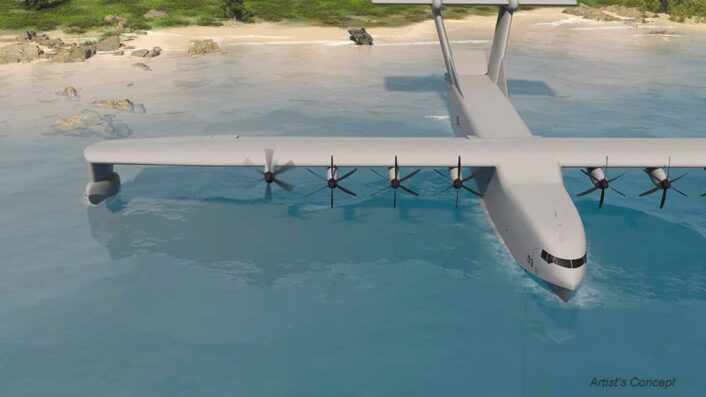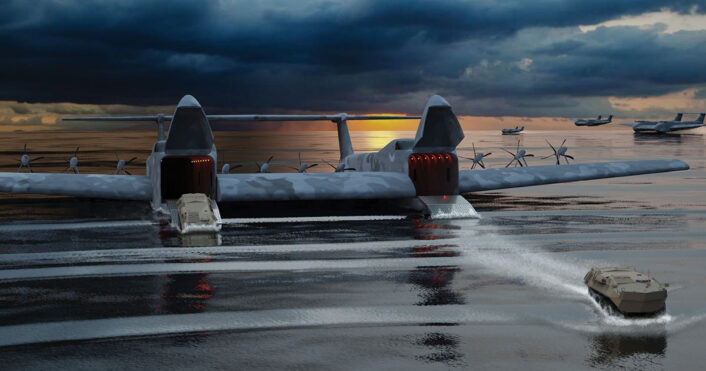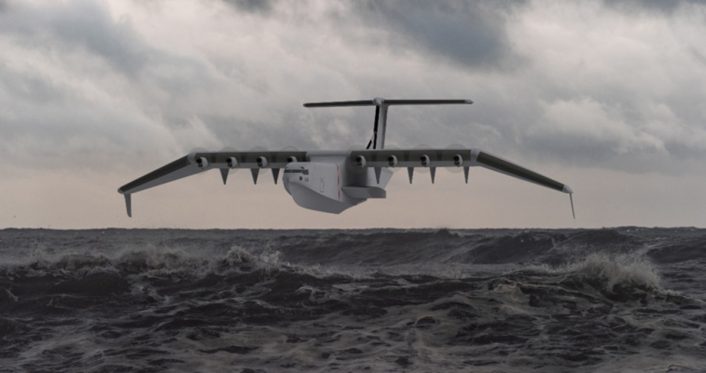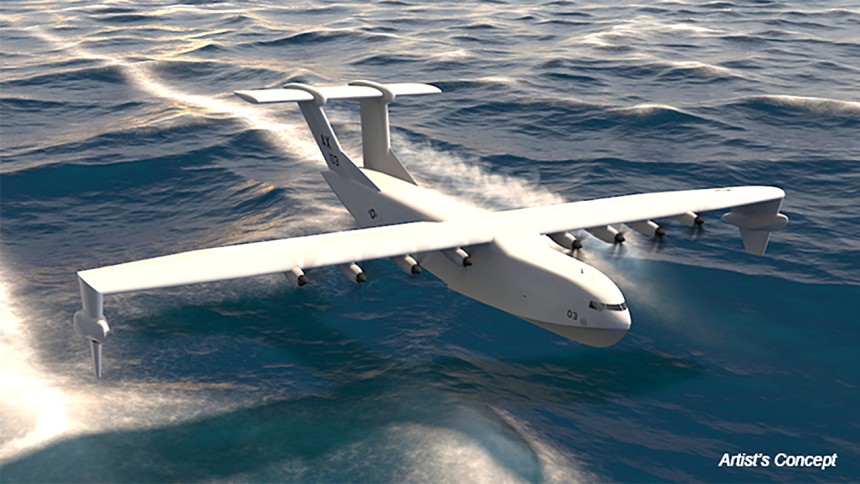If Aurora’s concept passes the Preliminary Design Review by 2025, it will be expected to float, fly and then demonstrate the Liberty Lifter by late-2027 or early 2028.
Following General Atomics’ exit from the Liberty Lifter program under the DARPA (Defense Advanced Research Projects Agency), Aurora Flight Sciences (AFS) will continue designing the experimental heavy cargo seaplane. This after General Atomics design for the aircraft could not meet the project’s vision to have a similar payload-carrying to the C-17 Globemaster III.
According to Defense News, the Pentagon last week announced that AFS, a subsidiary of Boeing, received an “$8.3 million modification to keep working on its mobility seaplane design.” In February 2023, DARPA announced selecting teams from General Atomics and AFS to develop the concept designs for the Liberty Lifter Seaplane Wing-in-Ground effect “full scale demonstrator.”

The General Atomics’ design proposed an unorthodox twin-hull for the Liberty Lifter, intended to make the aircraft more stable on water. The concept art showed the plane’s noses would have lifted up – like the C-5 Galaxy – to deploy the cargo and for vehicles to roll off on the beach or a shore.
Aurora’s design is closer to a traditional large seaplane or a flying boat aircraft, having a single hull, high-wing configuration, powered by eight turboprop engines. Another concept illustration showed wings that dropped downwards with floats on the wingtips.
By February 2024, AFS announced being selected for Phase 1 of the program. The concept aircraft operates on a unique scientific principle of being able to hover and travel just above the water, without actually touching the surface. These are known as ‘Ground Effect’ vehicles (to be explained subsequently). DARPA’s full name for the project is the “Liberty Lifter Seaplane Wing-in-Ground Effect.

AFS at the time said that Phase 1 aimed to “design, build, float, and fly an affordable X-plane that demonstrates revolutionary heavy-air-lift capability from the sea.” The firm will be funded for six months to “reach conceptual design review of a wing-in-ground-effect seaplane.”
‘General Atomics Design Not Suitable’
The report quoted a statement from DARPA’s Liberty Lifter program manager Dr. Christopher Kent the General Atomics Design could not meet the project’s need “to create transformational change.” “When we reached the point where we realized only one performer was meeting our aggressive schedule and technical goals, we streamlined the program to continue to deliver innovation.”
Mark Brinkley, a spokesman for General Atomics Aeronautical Systems, said in an email to Defense News that the company wants to continue working with DARPA on other programs and wishes the Liberty Lifter program success.
“I think we all recognize the Liberty Lifter concept represents a real technological shift for future combat operations, and we made a strong proposal informed by a lot of experience and expertise,” Brinkley said. “You always want to win and keep working on these things, but more than that we just want to see the program thrive and deliver a unique capability for the warfighter and the nation.”
What Are Wing-in-Ground Effect Vehicles?
Wing-in-Ground Effect vehicles, also called Ekranoplans, are a hybrid between airplanes and ships. They move over water without actually touching it.
The International Maritime Organization classifies them as ships. But the principle behind their operation is entirely unlike one.
They attain their unique high-speed by skimming the water’s surface at a height of between one and five meters (three to 16 feet). It can, therefore, be said that they share some of their characteristics with seaplanes, hovercrafts, and hydrofoils.
This aerodynamic principle is called the “ground effect.” The formation of wingtip vortices increases the efficiency of the wing. This effect, however, does not occur at high altitudes. This low-altitude flight ensures they are invisible to radars meant for aircraft. The water operation eliminates the need for docks or runways, while the payload capacity is greater than regular aircraft of the same size.
The proximity to the surface while flying makes them difficult to detect by radar. It is likely however that their ‘sea skimming’ might still not completely protect them from being detected, since large size makes for a big radar target, which might be visible to coastal radars. But given the emerging confrontation with China in the Indo-Pacific, where logistical capability to sustain a conflict is a major concern, American planners therefore continue to see relevance.
Aurora Flight Sciences’ Design
Aurora’s concept would employ “a robust and adaptive control system designed to meet the challenge of operations to and from the sea surface and at low altitude around waves and obstacles,” the statement added.
Operating on an unusual aerodynamic principle would require different sensors, avionics, and electronics to control flight handling. The firm recognized the challenge, touching upon the complicated engineering and physics involved.
For the “half-boat, half-airplane concept,” AFS has partnered with leading marine engineering company Gibbs & Cox.

This combines “aeronautics and naval design expertise to propose a modern-day Liberty ship that flies.” It has also tied up with Oregon-based shipyard ReconCraft, that specializes in maritime engineering.
According to DARPA, the Liberty Lifter is now in “Phase 1b,” set for Preliminary Design Review in early-2025. If successful, AFS will continue refining the design and then build the aircraft. Subsequently, AFS will float, fly and then demonstrate the Liberty Lifter, with the first flight scheduled to occur by late-2027 or early 2028.
DARPA’s Vision
DARPA stipulated a ferry range greater than 6,500 nautical miles (nm), being able to ‘hover’ with ‘flying-in-ground-effect’ in sea states up to 5 (or waves up to 13 feet in height), and a capacity to carry two US Marine Corps (USMC) Amphibious Combat Vehicles (ACV) or six twenty-foot container units.
“Goals include takeoff and land in Sea State 4, sustained on-water operation up to Sea State 5, and extended flight close to the water in ground effect with the capability to fly out of ground effect at altitudes up to 10,000-feet above sea level,” DARPA said.
Defense News added that DARPA “originally envisioned” the Liberty Lifter as having about the same size and capacity of a C-17 Globemaster, but has since “scaled back the demonstrator program to about the size of a C-130 Hercules.” However, DARPA’s budget documents for fiscal 2025 show that a future Liberty Lifter aircraft could be built to roughly a C-17′s scale once there’s proof the concept works.
The Globemaster has a wingspan of more than 169-feet, at 174-feet long and a height of roughly 55-feet. It can carry 77,518-kg of cargo. In comparison, the Hercules’ wingspan is more than 132-feet, with the longest variants at about 97-feet in length, and a maximum height of 38-feet. One variant can carry a payload of nearly 20,000-kg.









